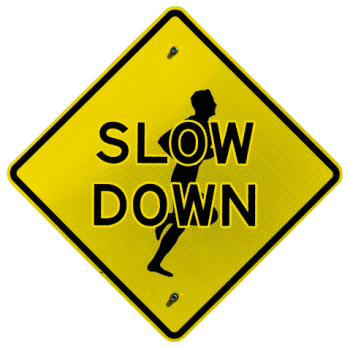What Is A Slow Run? Benefits, Adding It To Your Training & How To Slow Down

I will be honest; I was skeptical. When I read that most runners do their long, slow-distance runs way too fast; I was not sure that was a thing. What do you mean, “too fast?” I mean, if you want to run fast on race day, you have to run fast …. right?
The answer is no. You don’t have to run fast all of the time to perform beautifully on race day. Let’s talk about the benefits of slow running.
What Is a Slow Run?
Simpy put, a slow run is a purposeful slow running pace compared to your normal pace. It’s a relative pace that may vary based on your average mile, 5K, or half marathon pace.
We’re all different, so putting a specific time on slow runs isn’t possible. But, here are a few examples you can use as a reference;
Example #1 – You run a 5K in 30 minutes. You ran 9 minutes and 40-second mile pace. Your slow run could be 12-minute miles.
Example #2 – You run a half marathon in under 2 hours. You ran about 9-minute miles. Your slow run could be 10-minute and 30-second miles.
Another way to talk about slow runs is by labeling them “easy miles”. They’re an important factor in any training plan, so let’s dive deeper into the concept of slow runs.
Benefits of Slow Running

Establish efficient form: Slow running allows you to focus on your form and be sure you are checking all of the right boxes.
Decreased injury: Running easy will lessen your chance of injury while still giving you time on your feet.
Higher mileage: Another benefit is you can increase your overall volume of miles while taking it easy on your body.
Strengthens cardiovascular system: Even if you are not running hard, you are still working your cardio system for an extended period of time.
Stronger muscles: More time running will result in stronger muscles.
Fat burning: Your ability to burn fat will increase due to these slow, longer runs.
Promotes recovery: There are many recovery benefits to slow and easy running.
Does Slow Running Help You Run Fast?
Too many novice coaches have their athletes running much too quickly as they hammer out the miles. Certainly, you need some hard effort in your workouts. If you run slow all the time, your body gets acclimated to that pace.
There is an entire school of thought that revolves around the 80/20 philosophy.
80/20 Philosophy: Slow vs. Fast Running
According to the 80/20 philosophy of running, approximately 80% of your running should be slow and easy. That leaves only 20% of your workouts to be left for tempo, fartleks, speedwork, and other such tasks.
While some people most definitely think that slow running is counterproductive, there is a lot of research behind it working. This includes why it works and the benefits of slow running.
How Slow Is Too Slow?
Famous running programs like McMillian, Jack Daniels, and Maffetone would tell you that there is no such thing as too slow. Honestly, you will probably bore yourself to tears and get frustrated before you will run slow enough for long enough.

Did you know those elite runners often do their slow runs at almost double their race pace? That is correct; you heard that right. A 5:00 minute miler will complete some super slow recovery runs at a pace between 9:00 – 10:00 minutes per mile. So if it is good practice for elites, why do we think we have to do something different?
Is Running Slow Still a Good Workout?
First, define a good workout. If the workout on your schedule is to run 4-5 miles, and you run those miles, that is a good workout. Isn’t it? If your coach gives you a warm-up, then tells you to run 8 x 400 at a set pace, with a certain amount of recovery, that is a very different type of workout. But here’s the thing… there is a clear time, place, and purpose for both workouts.
If your coach (or training plan or mentor) tells you that you should be running slow, there is most likely a very good reason for that assignment. You just can’t discount slow running because it feels lazy to you.
Struggling to Slow Down
Many people struggle to slow down. Honestly, I do also. I have set out intending to run nice and easy, and then when I glance down, I’m going way faster than I intended to run. Here are some tips to help you slow down.
If you have a fancy smartwatch, see if it will cue you to pace. My Garmin, for example, can be set to vibrate or beep as a warning if I am in the correct (or incorrect) pace zone.
The first time I tried this, my Garmin buzzed approximately 1,579,391 times. And that was in the first 2 miles. As I got further along, I managed to zero in a bit more accurately on a particular pace.
Another suggestion is to use heart rate training. If I am trying to slow down, I may try to keep my heart rate below a certain point. Once, my goal was to keep my HR below a 135. Now I have a pretty low heart rate, but that was super hard for me to run at all and keep my heart rate that low. I found I would inch above 135, then have to walk. There were a lot of walk intervals to keep my HR where I wanted it.
Honestly, my favorite way to slow down is to find a buddy who is slower than I am. If I am hoping for a nice and easy run, I call a friend who I am certain will make me slow my roll.
Then I am committed to whatever pace she would run. I settle in, try to stay just a half a pace off of her left shoulder, and enjoy the company. This way, I have company, and I am not in control of the pace. This is a win-win as far as I am concerned.

I do have one more tactic I use. I call it Waylon Running. I have a black lab puppy who I am just teaching to run with me. His attention span is the size of a gnat. Still learning how to jog on the hands-free leash, he can be a handful.
He also likes to stop and sniff, explore, pee on things… you get the drift. Since he is a relatively new running buddy, we typically do 1:00 minute on x 1:00 minute off intervals. This has taught me patience and also keeps me grounded and focused.
Note: You should not run with a puppy until your veterinarian has cleared him or her to run. This is usually when he or she is somewhere between 12-18 months old.
If you have doubts if slow running has benefits and will work for you, I would encourage you to try it. Give it 8 weeks of running a good chunk of your workouts nice and easy, and do the rest of it harder and with more “quality” running. Then toe the line and see what your body is capable of. You won’t regret it.
Latest Articles
 Is Running on a Treadmill Easier Than Running Outside?Runners have their own preferences, whether it is treadmill running, running outside on the road, or exploring trails. So...
Is Running on a Treadmill Easier Than Running Outside?Runners have their own preferences, whether it is treadmill running, running outside on the road, or exploring trails. So... Is It OK to Use Trail Running Shoes on the Road?While trail running shoes can be used on roads, especially in situations where a runner encounters mixed terrains or pref...
Is It OK to Use Trail Running Shoes on the Road?While trail running shoes can be used on roads, especially in situations where a runner encounters mixed terrains or pref... How to Fix Sore Quads After Running?Rest, ice, gentle stretching, and over-the-counter pain relievers can help soothe sore quads after running. Also, ensure ...
How to Fix Sore Quads After Running?Rest, ice, gentle stretching, and over-the-counter pain relievers can help soothe sore quads after running. Also, ensure ... 10 Fruits With The Most Electrolytes to Replace Sports DrinksThese fruits are high in electrolytes such as potassium, magnesium, and calcium, essential for hydration, muscle function...
10 Fruits With The Most Electrolytes to Replace Sports DrinksThese fruits are high in electrolytes such as potassium, magnesium, and calcium, essential for hydration, muscle function...

